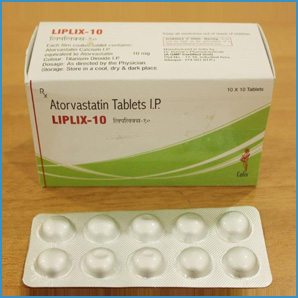
LIPLIX
(ATORVASTATIN 10mg TABLETS)
LIPLIX (atorvastatin calcium) is a synthetic lipid-lowering agent. Atorvastatin calcium is a white to off-white crystalline powder that is insoluble in aqueous solutions of pH 4 and below. Atorvastatin calcium is very slightly soluble in distilled water. LIPLIX tablets for oral administration contain Atorvastatin 10 mg
CLINICAL PHARMACOLOGY
Mechanism of Action
Atorvastatin is a selective, competitive inhibitor of HMG-CoA reductase, the rate-limiting enzyme that converts 3-hydroxy-3-methylglutaryl-coenzyme A to mevalonate, a precursor of sterols, including cholesterol.
Cholesterol and triglycerides circulate in the bloodstream as part of lipoprotein complexes. With ultracentrifugation, these complexes separate into HDL (high-density lipoprotein)LDL (low-density lipoprotein), and VLDL (very-low-density lipoprotein) fractions.
|
|
Triglycerides (TG) and cholesterol in the liver are incorporated into VLDL and released into the plasma for delivery to peripheral tissues. LDL is formed from VLDL and is catabolized primarily through the high-affinity LDL receptor. Clinical and pathologic studies show that elevated plasma levels of total cholesterol (total-C), LDL-cholesterol (LDL-C), and apolipoprotein B (apo B) promote human atherosclerosis and are risk factors for developing cardiovascular disease, while increased levels of HDL-C are associated with a decreased cardiovascular risk. In animal models, LIPLIX lowers plasma cholesterol and lipoprotein levels by inhibiting HMG-CoA reductase and cholesterol synthesis in the liver and by increasing the number of hepatic LDL receptors on the cell-surface to enhance uptake and catabolism of LDL; LIPLIX also reduces LDL production and the number of LDL particles. LIPLIX reduces LDL-C in some patients with homozygous familial hypercholesterolemia (FH), a population that rarely responds to other lipid-lowering medication.
LIPLIX reduces total-C, LDL-C, and apo B in patients with homozygous and heterozygous FH, nonfamilial forms of hypercholesterolemia, and mixed dyslipidemia.
LIPLIX also reduces VLDL-C and TG and produces variable increases in HDL-C and apolipoprotein A-1. LIPLIX R reduces total-C, LDL-C, VLDL-C, apo B, TG, and non- HDL-C, and increases HDL-C in patients with isolated hypertriglyceridemia.
Pharmacodynamics
Atorvastatin as well as some of its metabolites are pharmacologically active in humans. The liver is the primary site of action and the principal site of cholesterol synthesis and LDL clearance. Drug dosage rather than systemic drug concentration correlates better with LDL-C reduction. Individualization of drug dosage should be based on therapeutic response
Pharmacokinetics and Drug Metabolism
Absorption :
Atorvastatin is rapidly absorbed after oral administration; maximum plasma concentrations occur within 1 to 2 hours. Extent of absorption increases in proportion to atorvastatin dose. The absolute bioavailability of atorvastatin is approximately 14% and the systemic availability of HMG-CoA reductase inhibitory activity is approximately 30
|
|
Metabolism :
Atorvastatin is extensively metabolized to ortho- and parahydroxylated derivatives and various beta-oxidation products. In vitro studies suggest the importance of atorvastatin metabolism by cytochrome P450 3A4, consistent with increased plasma concentrations of atorvastatin in humans following co administration with erythromycin, a known inhibitor of this isozyme.
Excretion :
Atorvastatin and its metabolites are eliminated primarily in bile following hepatic and/or extra-hepatic metabolism; however, the drug does not appear to undergo enterohepatic recirculation. Mean plasma elimination half-life of atorvastatin in humans is approximately 14 hours, but the half-life of inhibitory activity for HMG-CoA reductase is 20 to 30 hours due to the contribution of active metabolites. Less than 2% of a dose of atorvastatin is recovered in urine following oral administration.
Special Populations
Geriatric :
Plasma concentrations of atorvastatin are higher (approximately 40% for Cmax and 30% for AUC) in healthy elderly subjects (age =65 years) than in young adults. Clinical data suggest a greater degree of LDL-lowering at any dose of drug in the elderly patient population compared to younger adults
Pediatric :
Pharmacokinetic data in the pediatric population are not available.
Dosage 5-20mg/day once daily |



